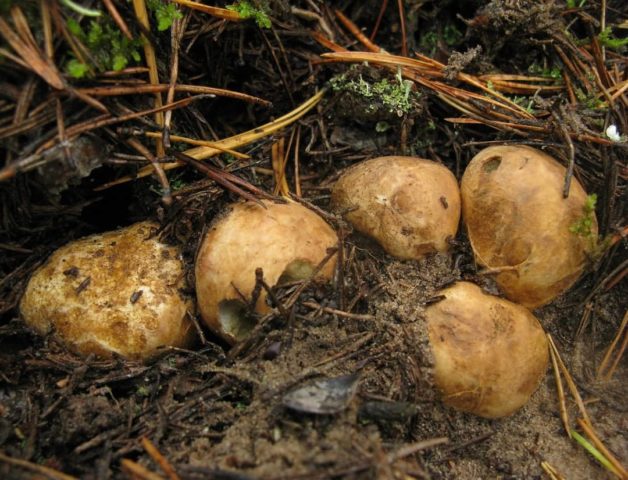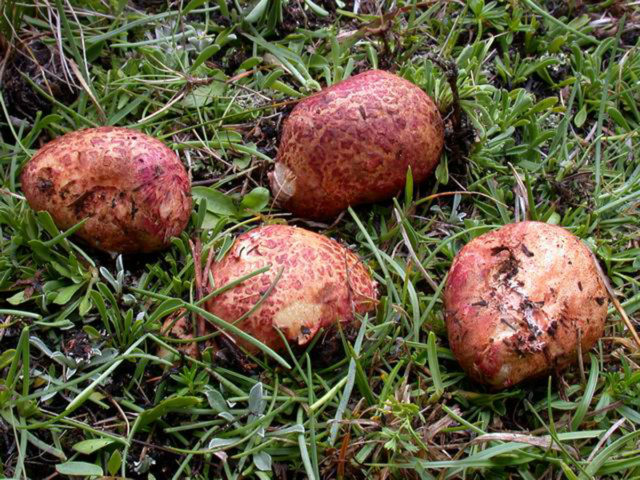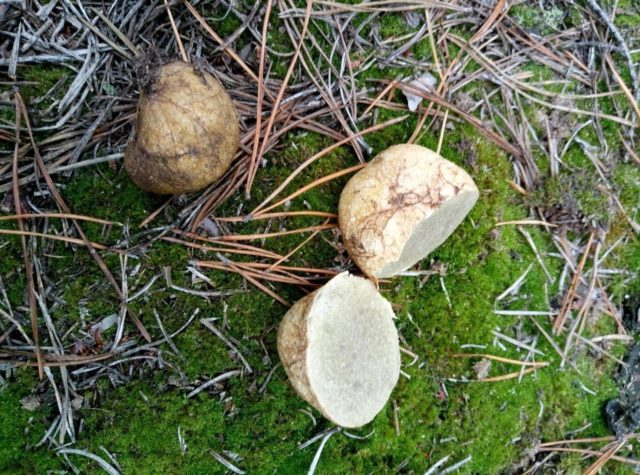Content
Rhizopogon yellowish - a rare saprophyte mushroom, a relative of raincoats. Belongs to the class Agaricomycetes, family Rizopogonovye, genus Rizopogon. Another name for the mushroom is yellowish root, in Latin - Rhizopogon luteolus.
Where yellowish rhizopogons grow
Rhizopogon luteolus is found throughout the temperate and northern latitudes of Eurasia. Grows in small groups mainly in pine forests on sandy and sub-sandy soils. Forms mycorrhiza with conifers, most often with pines. It can be found in wooded summer cottages and parks. Loves loose soils with a high nitrogen content. The fruiting body of the fungus is almost completely hidden underground or under a layer of fallen leaves, so it is not easy to find it.
What do yellowish rhizopogons look like?
Rhizopogon luteolus has a rather strange appearance for a fungus. He is missing a hat and a leg. The division of the fruiting body into upper and lower parts is rather arbitrary. Outwardly, it resembles a tuber of young potatoes. Has a size from 1 to 5 cm.
Young specimens are whitish-olive or light brown, mature ones are brown or brown. The surface of the fruiting body is dry. As it grows, its skin gradually cracks. The fruit body is entangled with gray-black mycelium filaments. Mature specimens have a pronounced garlic smell.
The pulp of Rhizopogon is dense and fleshy, whitish-yellow in color, which is why the mushroom got its name. When the spores mature and scatter them in the pulp, it gradually changes color to yellow-olive, greenish, greenish-brown and almost black in the old specimen.
Spores are ellipsoidal, slightly asymmetric, shiny, smooth, transparent. The size of the spores is approximately 8 x 3 µm.
Is it possible to eat yellowish rhizopogons
Rizopogon is an edible species, but it is rarely eaten.
Taste qualities of the mushroom yellowish rhizopogon
Rhizopogon luteolus has a low taste. Despite the fact that it is considered edible.
Fried Rhizopogon tastes like a raincoat.
Benefits and harm to the body
Rhizopogon luteolus belongs to the fourth flavor category. The composition contains nutrients, but if used and prepared incorrectly, it is dangerous and can harm the body.
False doubles
Rhizopogon yellowish is similar in appearance to its relative - pinkish rhizopogon (Rhizopogon roseolus), another name for which is a blushing truffle or a turning pink truffle. This mushroom has a yellowish skin, if broken or cut, the flesh turns pink in this place. The fruit body of a pinking truffle has a tuberous or irregularly rounded shape. Most of it is underground. The wall of the fruiting body is whitish or yellowish; when pressed, it becomes pinkish. Rhizopogon pinkish edible, suitable for consumption only at a young age.
Another relative of the yellowish rhizopogon is the common rhizopogon (Rhizopogon vulgaris).Its fruiting body is shaped like a raw potato tuber up to 5 cm in diameter. It is partially or completely hidden in the ground. The skin of a young mushroom is velvety; in a mature one, it becomes smooth and slightly cracks. Grows in spruce and pine forests, sometimes found in deciduous. The harvesting season is from June to October. Never grows alone.
Rhizopogon yellowish resembles dubious melanogaster (Melanogaster ambiguus). It is a very rare edible mushroom that grows singly in deciduous forests from May to October. Young specimens have a brownish-grayish tomentose rough surface. In the process of growth, the surface of the fruiting body darkens, becoming almost black, becomes smooth. The pulp of the mushroom is purple-black, thick, fleshy, with a slight smell of garlic. Low taste.
Collection rules
The harvesting season is from July to September. Rhizopogon luteolus is best harvested at the end of the season when it produces the highest yields.
Use
For eating, it is necessary to choose young specimens with a pleasant creamy pulp (old dark mushrooms cannot be used).
First, they must be rinsed under running water, carefully rubbing each copy to remove the garlic taste and smell, then peel the thin skin.
Rhizopogon luteolus is prepared in the same way as raincoats, which are their closest relatives. All types of culinary processing are suitable for cooking - boiling, frying, stewing, baking, but they are most delicious when fried.
Conclusion
Rhizopogon yellowish - a little-known species even among mushroom pickers. It is easy to confuse it with a white truffle, which is used by scammers selling it at a high price.












